The European Organization for Research and Treatment of Cancer (EORTC) Breast Group and the Radiotherapy Group successfully completed several clinical trials that included thousands of patients with the goal of improving outcomes by evaluating different approaches in the locoregional treatment of breast cancer. These trials addressed the need for and feasibility of alternative or more aggressive treatment regimens and new ways to predict therapeutic outcomes. For ductal carcinoma in situ (DCIS), the contribution of radiotherapy in achieving local control was examined. For stage I and II breast cancer, mastectomy was compared with breast-conserving therapy. This was followed by a trial in which 2 different dose levels of irradiation were tested (ie, is an extra boost dose required after whole-breast irradiation?). Reduction of morbidity is the aim of the After Mapping of the Axilla Radiotherapy or Surgery (AMAROS) trial comparing axillary lymph node dissection with axillary irradiation in patients with proven axillary metastases in the sentinel nodes. For locally advanced breast cancer, the contribution of hormonal therapy and chemotherapy was investigated. Finally, the possibility of predicting treatment outcomes and therefore individualizing treatment regimens is explored in ongoing trials incorporating genomic profiles. A selection of the EORTC breast cancer trials is presented in this overview, followed by some of the new studies and suggestions for future research.
A randomized trial was conducted to investigate the role of breast radiotherapy after local excision of DCIS. We analyzed the efficacy of radiotherapy with 10 years of follow-up on both the overall risk of local recurrence (LR) and according to clinical, histologic, and treatment factors.
After microscopically complete local excision, women with DCIS were randomly assigned to no further treatment or radiotherapy (50 Gy whole-breast irradiation). One thousand and ten women with mostly (71%) mammographically detected DCIS were included. The median follow-up was 10.5 years.1,2
The 10-year LR-free rate was 74% in the group treated with local excision alone compared with 85% in the women treated by local excision plus radiotherapy (log-rank p < 0.0001; hazard ratio [HR] = 0.53). (Fig. 45-1A) The risk of DCIS and invasive LR was reduced by 48% (p = 0.0011) and 42% (p = 0.0065), respectively (Fig. 45-1B and 45-1C). Both groups had similar low risks of metastases and death. At multivariate analysis, factors significantly associated with an increased LR risk were young age (≤40 years; HR = 1.89), symptomatic detection (HR = 1.55), intermediately or poorly differentiated DCIS (as opposed to well-differentiated DCIS; HR = 1.85 and HR = 1.61, respectively), cribriform or solid growth pattern (as opposed to clinging/micropapillary subtypes; HR = 2.39 and HR = 2.25, respectively), doubtful margins (HR = 1.84), and treatment by local excision alone (HR = 1.82). The effect of radiotherapy was homogeneous across all assessed risk factors (Fig. 45-1D).
Figure 45-1
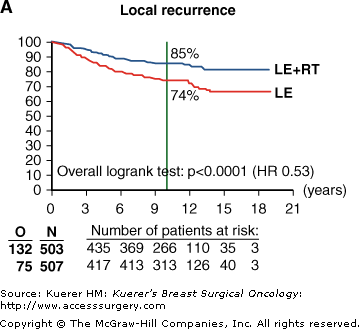

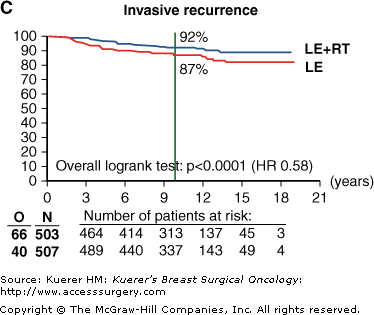

Phase III trial of radiation therapy versus no treatment for patients with in situ ductal carcinoma of the breast (EORTC 10853). Time to recurrence by treatment arm. A. All local recurrences. B. Ductal carcinoma in situ (DCIS) recurrences. C. Invasive recurrence. D. Effect of radiotherapy on local control by subgroup. (CI, 95% confidence interval; HR, hazard ratio; LE, local excision; N, number of patients; O, observed; RT, radiotherapy.) [Reproduced, with permission, from Bijker N, Meijnen P, Peterse JL, et al. Breast-conserving treatment with or without radiotherapy in ductal carcinoma-in-situ: ten-year results of European Organisation for Research and Treatment of Cancer randomized phase III trial 10853—a study by the EORTC Breast Cancer Cooperative Group and EORTC Radiotherapy Group. J Clin Oncol. 2006;24(21):3381-3387.]
We concluded that radiotherapy after local excision for DCIS reduced the risk of LR, with a 47% reduction at 10 years. All patient subgroups benefited from radiotherapy.
Breast-conserving therapy (BCT) has been shown to be as effective as mastectomy in the treatment of tumors upto 2 cm. However, evidence of its efficacy, over the long term, in patients with tumors less than 2 cm was limited at that time. From May 1980 to May 1986, a randomized, multicenter trial comparing BCT with modified radical mastectomy for patients with tumors up to 5 cm was carried out.3,4 In this analysis, we investigated whether the 2 treatments resulted in different overall survival, time to distant metastasis, or time to locoregional recurrence.
Of the 868 eligible breast cancer patients randomly assigned to the BCT arm or to the modified radical mastectomy arm, 80% had a tumor of 2.1 to 5 cm. BCT comprised lumpectomy with an attempted margin of 1 cm of healthy tissue and complete axillary clearance, followed by radiotherapy to the breast and a supplementary dose to the tumor bed. The median follow-up was 13.4 years. All p values are 2 sided.
At 10 years, there was no difference between the 2 groups in overall survival (66% for the mastectomy patients and 65% for the BCT patients; p = 0.11) or in distant metastasis-free rates (66% for the mastectomy patients and 61% for the BCT patients; p = 0.24). The rates of locoregional recurrence (occurring before or at the same time as distant metastasis) at 10 years did show a statistically significant difference (12% of the mastectomy and 20% of the BCT patients; p = 0.01) (Fig. 45-2).
Figure 45-2
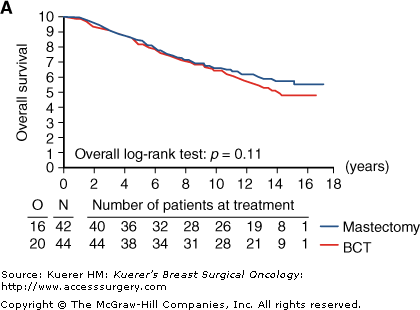
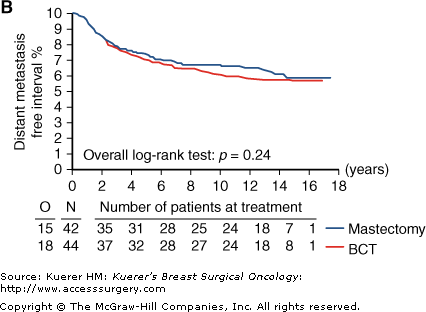
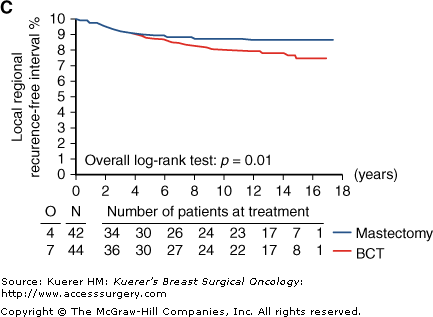
Randomized clinical trial to assess the value of breast-conserving therapy in stage I and stage II breast cancer (EORTC Trial 10801). Kaplan-Meier curves for (A) overall survival, (B) distant metastases-free survival, (C) locoregional recurrence-free survival in patients with a diagnosis of clinical stage I or II invasive carcinoma of the breast treated with either breast-conserving therapy (BCT) plus breast radiotherapy or with mastectomy. (N, number of patients; O, observed.) [Reproduced with permission, from Van Dongen JA, Voogd AC, Fentiman IS, et al. Long-term results of a randomized trial comparing breast-conserving therapy with mastectomy: European Organization for Research and Treatment of Cancer 10801 trial. J Natl Cancer Inst. 2000;92(14):1143-1150.]
We concluded that BCT and mastectomy resulted in similar survival rates in a trial in which the great majority of the patients had stage II breast cancer. However, a slightly higher local recurrence rate was seen in the BCT arm.
EORTC Trial 22881-10882: The Boost versus No Boost Irradiation after Whole-Breast Irradiation in Stage I and II Breast Cancer
The long-term impact of a boost radiation dose of 16 Gy was investigated in a randomized phase III trial with the following end points: local control, fibrosis, and overall survival for patients with stage I and II breast cancer who underwent breast-conserving therapy.5,6
A total of 5318 patients with microscopically complete excision followed by whole-breast irradiation of 50 Gy were randomly assigned to receive either a boost dose of 16 Gy (2661 patients) or no boost dose (2657 patients). At the time of the last analysis, median follow-up was 10.8 years.
The median age was 55 years. Local recurrence was reported as the first treatment failure in 278 patients with no boost versus 165 patients with boost; at 10 years, the cumulative incidence of local recurrence was 10.2% versus 6.2% for the no boost and the boost group, respectively (p < 0.0001). The HR of local recurrence was 0.59 (0.46 to 0.76) in favor of the boost, with no statistically significant interaction according to age (Fig. 45-3). The absolute risk reduction at 10 years according to age group was the largest in patients ≤40 years of age: 23.9% versus 13.5% (p < 0.0014). As a result, the number of salvage mastectomies has been reduced by 41%. Severe fibrosis was statistically significantly increased (p < 0.0001) in the boost group, with a 10-year rate of 4.4% versus 1.6% in the no boost group (p < 0.0001). Survival at 10 years was 82% in both arms (Fig. 45-3).
Stay updated, free articles. Join our Telegram channel

Full access? Get Clinical Tree







